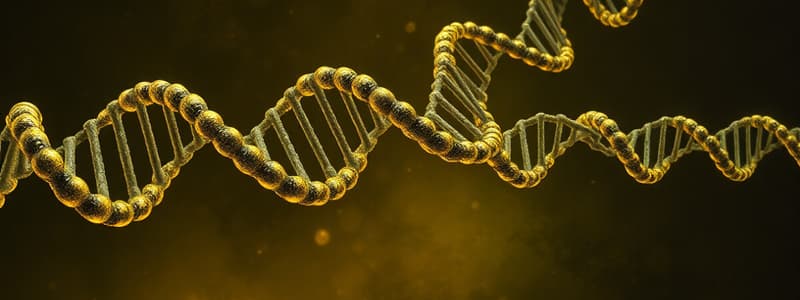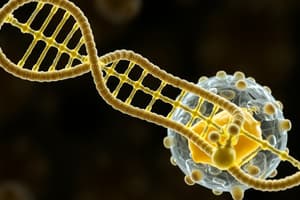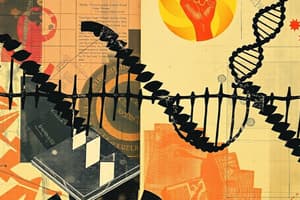Podcast
Questions and Answers
Which amino acid is coded by the codon 'GGA'?
Which amino acid is coded by the codon 'GGA'?
- Serine
- Proline
- Leucine
- Glycine (correct)
What is the role of RNA polymerase during transcription?
What is the role of RNA polymerase during transcription?
- To bind with sigma to stabilize the DNA
- To unwind the DNA double helix
- To recognize the promoter site
- To synthesize mRNA from the DNA template (correct)
Which strand of DNA is known as the sense strand?
Which strand of DNA is known as the sense strand?
- The strand that directs RNA synthesis
- The strand that runs in the 3' to 5' direction
- The strand that contains the genetic information for protein synthesis (correct)
- The strand that is complementary to the antisense strand
Which statement about degeneracy of amino acids is correct?
Which statement about degeneracy of amino acids is correct?
What is the purpose of the sigma protein in transcription?
What is the purpose of the sigma protein in transcription?
What does the mRNA codon UAG correspond to in the DNA template during transcription?
What does the mRNA codon UAG correspond to in the DNA template during transcription?
What is the primary role of RNA primers during DNA replication?
What is the primary role of RNA primers during DNA replication?
How do mutations at the 3’ position of a nucleotide sequence affect codon translation?
How do mutations at the 3’ position of a nucleotide sequence affect codon translation?
What occurs immediately after RNA polymerase finishes synthesizing mRNA?
What occurs immediately after RNA polymerase finishes synthesizing mRNA?
During which stage of protein synthesis is the genetic code transferred from DNA to mRNA?
During which stage of protein synthesis is the genetic code transferred from DNA to mRNA?
Which of the following codons serves as an initiation codon for protein synthesis?
Which of the following codons serves as an initiation codon for protein synthesis?
What best describes the term 'degeneracy' in the genetic code?
What best describes the term 'degeneracy' in the genetic code?
What is the function of DNA ligase during DNA replication?
What is the function of DNA ligase during DNA replication?
How many total codons are there in the genetic code?
How many total codons are there in the genetic code?
Which of the following statements about the genetic code is NOT true?
Which of the following statements about the genetic code is NOT true?
What role does DNA polymerase I play in DNA replication?
What role does DNA polymerase I play in DNA replication?
What is the primary significance of DNA replication during cell division?
What is the primary significance of DNA replication during cell division?
What distinguishes semi-conservative replication from conservative and dispersive methods?
What distinguishes semi-conservative replication from conservative and dispersive methods?
Which enzyme is responsible for unwinding the DNA molecule during replication?
Which enzyme is responsible for unwinding the DNA molecule during replication?
What is the role of DNA polymerase during DNA replication?
What is the role of DNA polymerase during DNA replication?
In what direction does DNA polymerase extend the newly synthesized DNA strands?
In what direction does DNA polymerase extend the newly synthesized DNA strands?
What was the conclusion of the Meselson-Stahl experiment regarding DNA replication?
What was the conclusion of the Meselson-Stahl experiment regarding DNA replication?
Which statement accurately describes the function of topoisomerase in DNA replication?
Which statement accurately describes the function of topoisomerase in DNA replication?
What must occur first for DNA replication to begin?
What must occur first for DNA replication to begin?
Flashcards
DNA Replication
DNA Replication
The process where a DNA molecule makes a copy of itself.
Semi-Conservative Replication
Semi-Conservative Replication
A new DNA molecule consists of one original strand and one new strand.
Replication Fork
Replication Fork
The area where the DNA strands are separated during replication.
DNA Polymerase
DNA Polymerase
Signup and view all the flashcards
Topoisomerase
Topoisomerase
Signup and view all the flashcards
Helicase
Helicase
Signup and view all the flashcards
Leading Strand
Leading Strand
Signup and view all the flashcards
Lagging Strand
Lagging Strand
Signup and view all the flashcards
Leading strand synthesis
Leading strand synthesis
Signup and view all the flashcards
Lagging strand synthesis
Lagging strand synthesis
Signup and view all the flashcards
Okazaki fragments
Okazaki fragments
Signup and view all the flashcards
DNA ligase
DNA ligase
Signup and view all the flashcards
Genetic Code
Genetic Code
Signup and view all the flashcards
Codon
Codon
Signup and view all the flashcards
Transcription
Transcription
Signup and view all the flashcards
Translation
Translation
Signup and view all the flashcards
Degeneracy in Genetic Code
Degeneracy in Genetic Code
Signup and view all the flashcards
Non-degenerate Codon
Non-degenerate Codon
Signup and view all the flashcards
What is a Promoter Site?
What is a Promoter Site?
Signup and view all the flashcards
Sense Strand
Sense Strand
Signup and view all the flashcards
Antisense Strand
Antisense Strand
Signup and view all the flashcards
What happens to mRNA after transcription?
What happens to mRNA after transcription?
Signup and view all the flashcards
Study Notes
DNA Replication
- DNA replication involves duplicating a double-stranded DNA molecule, creating a copy of itself.
- This occurs during the interphase stage of cell division, specifically mitosis.
- Replication is crucial to ensure each daughter cell receives a copy of the parent DNA molecule's genetic information.
- The genetic information on the DNA molecule must be retained identically during replication.
DNA Replication Processes
- DNA unwinds and separates into two strands.
- Each strand acts as a template for synthesizing new complementary strands.
- Bases are added one at a time until two new DNA strands are created, precisely duplicating the original DNA.
Semi-Conservative Replication
- DNA replication is a semi-conservative process.
- The parent DNA strand separates into two strands.
- Each strand serves as a template for a new complementary strand.
- The newly formed double helix is half original DNA from the parent and half new DNA
- The semi-conservative model was established after Meselson and Stahl's 1958 experiments.
Mechanism of DNA Replication
- Helicases: Unwind the parent double helix.
- Single-strand binding proteins: Stabilize the unwound DNA.
- DNA polymerase: Synthesizes new DNA strands in a 5' to 3' direction.
- Leading strand: Synthesized continuously.
- Lagging strand: Synthesized discontinuously in short fragments (Okazaki fragments).
- DNA polymerase I: Replaces RNA primers with DNA.
- DNA ligase: Joins Okazaki fragments.
- Topoisomerase: Unknots and uncoils DNA to relieve unwinding strain.
- Primase: Creates RNA primers for DNA polymerase to start replication.
Meselson-Stahl Experiment
- Provided evidence that disproves the conservative and dispersive models of DNA replication.
Conservative Hypothesis
- Proposed that both parent DNA strands remain intact as a template to create a new DNA strand.
Dispersive Hypothesis
- Proposed that the new DNA molecule is made of fragments of older and new DNA strands.
Protein Synthesis and Stages
- Genetic information in DNA is used to synthesize polypeptides (proteins).
- Protein synthesis happens in two stages: Transcription and Translation.
Transcription
- Reads the DNA genetic code and transfers it to messenger RNA (mRNA).
Translation
- Converts the genetic code into a protein.
Genetic Code
- A sequence of bases on a gene.
- A gene is a sequence of bases that codes for a specific amino acid.
- A combination of three different bases (nucleotides) in a triplet sequence that codes for the 20 amino acids.
- A triplet of bases on the mRNA (a codon) specifies a particular amino acid.
- Codons are written 5' to 3'.
- AUG is an initiation codon and codes for methionine.
- UAA, UAG, and UGA are stop codons.
- The genetic code consists of 64 (4³) triplet base sequences or codons.
Degeneracy of the Genetic Code
- Some amino acids are specified by more than one codon.
- The genetic code is degenerate, meaning it has more codes than needed.
Transcription
- Transcription takes place similarly to DNA replication, with the double-stranded structure unwinding and one strand serving as a template for RNA formation.
- Unwinding is done by DNA helicase, breaking hydrogen bonds.
- The DNA strand used as a template is called the anti-sense strand.
- The corresponding mRNA created is called the sense strand.
Transcription Start Process
- Transcription is triggered when RNA polymerase joins to a sigma protein.
- RNA polymerase then binds to a promoter sequence in a DNA molecule.
- RNA polymerase reads the DNA anti-sense strand in the 3' to 5' direction, creating an mRNA sequence in the 5' to 3' direction
mRNA and Translation
- Three bases on the DNA strand match corresponding three bases on the mRNA (codon), e.g. ATC on DNA corresponds to UAG on mRNA
- mRNA moves to the cytoplasm to find a ribosome, and the DNA rewinds.
- mRNA moves out of the nucleus into the cytoplasm to ribosomes for translation to happen.
Translation
- mRNA travels to ribosomes in the cytoplasm.
- The genetic material (codons) on mRNA is interpreted to create amino acids(protein).
- Ribosomal RNA dissociates into small and large subunits.
- Large Ribosomal units consist of amino acyl site (A) and peptidyl site (P),where amino acids are joined by peptide bonds.
- The anticodon of transfer RNA (tRNA) reads the codon on the mRNA. Each codon represents an amino acid.
- Amino acids are attached at the 3' end of tRNA with aid from ATP and specific enzyme complexes(aminoacyl-tRNA synthetases).
- Ribosomes read mRNA in the same 5' to 3' direction as it was polymerized.
- Each of the 20 amino acids has their own type of tRNA to operate in a cell.
Studying That Suits You
Use AI to generate personalized quizzes and flashcards to suit your learning preferences.




